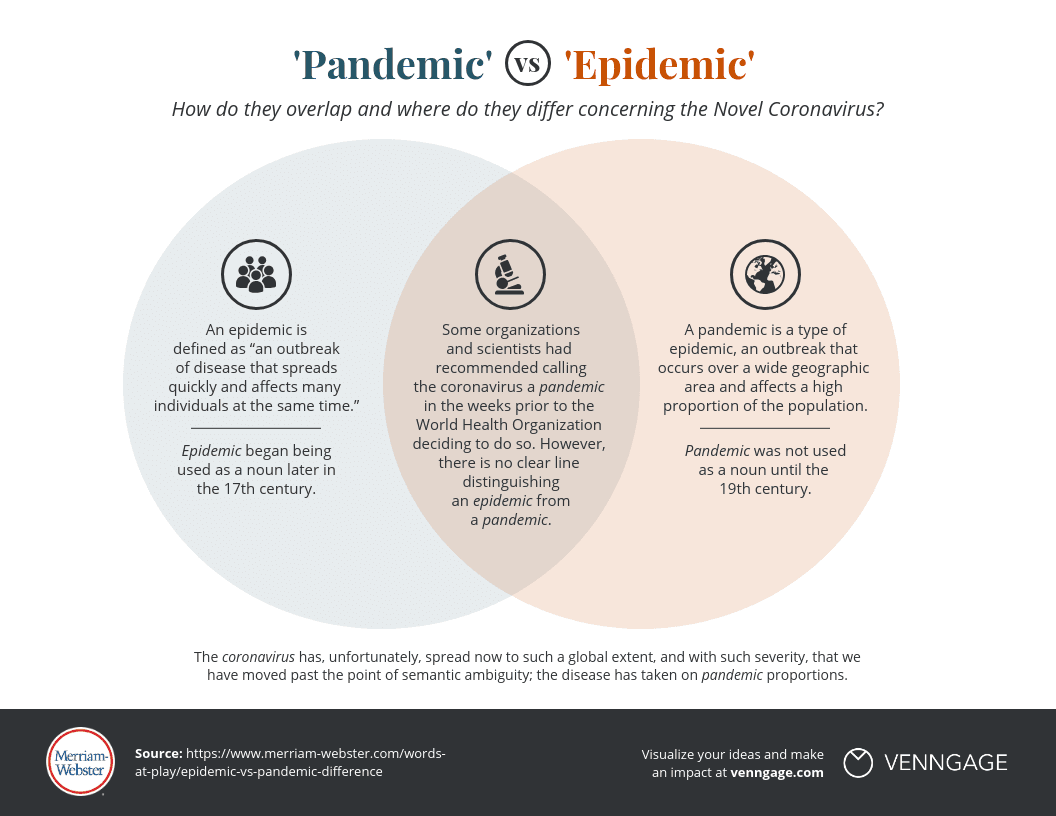What to KnowAn outbreak, which is a sudden localized incidence of a disease, can become an epidemic if it spreads over a larger area, infecting more people. If the spread escalates further, an epidemic can become a pandemic, which affects an even greater geographical area, with people in multiple countries and sometimes on multiple continents becoming infected.

Wash hands. Moisturize. Repeat.
On March 11th, 2020, the World Health Organization officially changed its designation of COVID-19, the illness caused by a novel coronavirus, from an epidemic to a pandemic, which raised an important question: What exactly does each designation mean?
‘Epidemic’ vs. ‘Pandemic’
An epidemic is an outbreak of disease—that is, sudden localized incidence of a disease—that spreads quickly and affects many individuals at the same time. A pandemic is a type of epidemic, one with greater range and coverage. A pandemic occurs over a wide geographic area and affects an exceptionally high proportion of the population.
And ‘Endemic’
If a disease lingers for a long time as an epidemic or a pandemic, it may eventually become endemic to an area, which means that it persists at a consistent level within a region.
The Origins and Uses of ‘Epidemic,’ ‘Pandemic,’ and ‘Endemic’
Epidemic, which can be traced to the Greek epidḗmios (“within the country, among the people, prevalent (of a disease)”), may carry broader meanings, such as “excessively prevalent,” “contagious,” or “characterized by very widespread growth or extent”; it is often used in a non-medical sense. Pandemic is less often encountered in a broad and non-medical sense, but it does have additional meanings, including “affecting the majority of people in a country or a number of countries”, “found in most parts of the world and in varied ecological conditions,” and “of or relating to common or sensual love” (in this last sense the word is usually capitalized). Pandemic comes from the Greek pándēmos, “of all the people, public, common, (of diseases) widespread,” which itself is from pan- (“all, every”) and dêmos (“people”). Beyond its public health use, endemic is also used by biologists to characterize plant and animal species that are found only in a given area. The en- of endemic means “in, within.”
Historical Use
Epidemic, pandemic, and endemic all entered English as adjectives in the 17th century.
An Epidemick plague, is a common and popular sicknesse, hapning in some region, or countrey, at a certaine time, caused by a certaine indisposition of the aire, or waters of the same region, producing in all sorts of people, one and the same kind of sicknesse.
— Thomas Lodge, A treatise of the plague, 1603These Praedicates certainly are not convertible with the fore-mentioned Diseases, and therefore ought not so rashly to be pronounced the Scorvey; which moreover is Endemick, the others Epidemick and Pandemick.
— Gideon Harvey, The disease of London, 1675
Epidemic took on noun use later in the 17th century; pandemic did not undergo this functional shift until the 19th. Endemic has been used as a noun only since the early 20th century; as a noun, it refers to an organism that is restricted or peculiar to a locality or region.
CHAP. X. Of Pestilential and malignant Feavers, together with the small Pox, and such other Epidemics, as are Communicated by infection.
— Anon., Pyretologia, 1674Those diseases which have some strong resemblance in their general characters, and attack many individuals in a large extent of country at about the same time, are commonly called epidemics. If all, or about all the inhabitants of a country be similarly attacked, at or near the same time, with a particular complaint, it is more properly called a pandemic.
— J. A. Allen, The Boston Medical and Surgical Journal, 5 Sept. 1832Why are the endemics still less numerous in proportion on the islands surrounding New Zealand than on New Zealand itself …?
— John Christopher Willis, Age and Area: A Study in Geographical Distribution and Origin of Species, 1922
On the Novel Coronavirus
Some organizations and scientists had recommended calling COVID-19 a pandemic in the weeks prior to the World Health Organization deciding to do so. It is worth noting, however, that there is no clear line distinguishing an epidemic from a pandemic. The latter is, from a public health perspective, worse than the former, but there is sufficient overlap between the two that at certain points consensus is unlikely. The coronavirus did, of course, spread to such a global extent, and with such severity, that we quickly moved past the point of semantic ambiguity; the disease had taken on pandemic proportions.
 Image by Venngage Infographic Maker.
Image by Venngage Infographic Maker.




